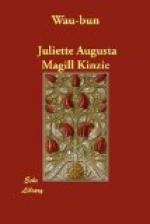[Footnote 26: A gentleman who visited Chicago at that day, thus speaks of it: “I passed over the ground from the fort to the Point, on horseback. I was up to my stirrups in water the whole distance. I would not have given sixpence an acre for the whole of it.”]
[Footnote 27: See Narrative of the Massacre, p. 159.]
[Footnote 28: Mr. Cat.]
[Footnote 29: This Narrative, first published in pamphlet form in 1836, was transferred, with little variation, to Brown’s “History of Illinois,” and to a work called “Western Annals.” It was likewise made, by Major Richardson, the basis of his two tales, “Hardscrabble,” and “Wau-nan-gee.”]
[Footnote 30: Burns’s house stood near the spot where the Agency Building, or “Cobweb Castle,” was afterwards erected, at the foot of N. State Street.]
[Footnote 31: This is done by cutting the meat in thin slices, placing it upon a scaffold, and making a fire under it, which dries it and smokes it at the same time.]
[Footnote 32: A trading-establishment—now Ypsilanti.]
[Footnote 33: Captain Wells, when a boy, was stolen, by the Miami Indians, from the family of Hon. Nathaniel Pope, in Kentucky. Although recovered by them, he preferred to return and live among his new friends. He married a Miami woman, and became a chief of the nation. He was the father of the late Mrs. Judge Wolcott, of Maumee, Ohio.]
[Footnote 34: The spot now called Bertrand, then known as Parc aux Vaches, from its having been a favorite “stamping-ground” of the buffalo which then abounded in the country.]
[Footnote 35: The exact spot of this encounter was about where 21st Street crosses Indiana Avenue.]
[Footnote 36: Along the present State Street.]
[Footnote 37: Mrs. Holt is believed to be still living, in the State of Ohio.]
[Footnote 38: Billy Caldwell was a half-breed, and a chief of the nation. In his reply, “I am a Sau-ga-nash,” or Englishman, he designed to convey, “I am a white man.” Had he said, “I am a Pottowattamie,” it would have been interpreted to mean, “I belong to my nation, and am prepared to go all lengths with them.”]
[Footnote 39: Frenchman.]
[Footnote 40: The Pottowattamie chief, so well known to many of the citizens of Chicago, now (1870) residing at the Aux Plaines.]
[Footnote 41: Twenty-two years after this, as I was on a journey to Chicago in the steamer Uncle Sam, a young woman, hearing my name, introduced herself to me, and, raising the hair from her forehead, showed me the mark of the tomahawk which had so nearly been fatal to her.]
[Footnote 42: Although this is the name our mother preserved of her benefactor, it seems evident that this chief was in fact Corn-Planter, a personage well known in the history of the times. There could hardly have been two such prominent chiefs in the same village.]




